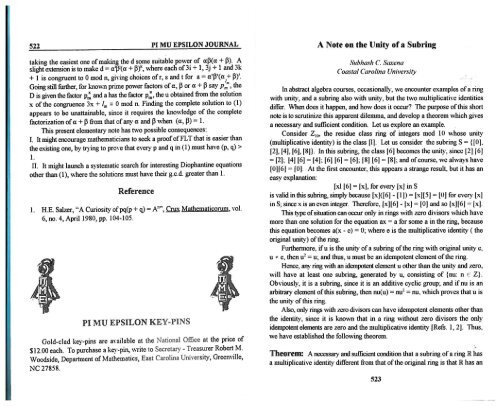Vol. 10 No 7 - Pi Mu Epsilon
Vol. 10 No 7 - Pi Mu Epsilon
Vol. 10 No 7 - Pi Mu Epsilon
Create successful ePaper yourself
Turn your PDF publications into a flip-book with our unique Google optimized e-Paper software.
522 PI MU EPSILON JOURNAL<br />
taking the easiest one of making the d some suitable powe~ of a~( a + p). A<br />
slight extension is to make d = ail)i(a + p)k, where each of3t + 1, 3J + 1 and 3k<br />
+ 1 is congruent to 0 mod n, gi'ing choices ofr, sand t for a= arps(a 1<br />
+ PY.<br />
Going still further, for kno\\n prime power factors of a, P or a+ P say Pmm, ~e<br />
D is given the factor p~ and a has the factor p~, the u obtained from th~ solunon<br />
x of the congruence 3x + lm = 0 mod n. Finding the complete solunon to (1)<br />
appears to be unattainable, since it requires the knowledge of the complete<br />
factorization of a + p from that of any a and P when (a, P) = 1.<br />
This present elementary note has two possible consequences:. .<br />
I. It might encourage mathematicians to seek a proof of FL T that 1s easter than<br />
the existing one, by trying to prm·e that every p and q in (1) must have (p, q) ><br />
1. .<br />
II. It might launch a systematic search for interesting Diophantine equations<br />
other than ( 1 ), where the solutions must have their g.c.d. greater than 1.<br />
Reference<br />
1. H.E. Salzer, "A Curiosity ofpq(p + q) =An", Cru.x Mathematicorum, vol.<br />
6, no. 4, April1980, pp. <strong>10</strong>4-<strong>10</strong>5.<br />
PI MU EPSILON KEY-PINS<br />
Gold-clad key-pins are available at the National Office at the price of<br />
$12.00 each. To purchase a key-pin, \\Tite to Secretary - Treas~er Robert. :M.<br />
Woodside, Department of Mathematics, East Carolina University, Greenville,<br />
NC 27858.<br />
A <strong>No</strong>te on the Unity of a Subring<br />
.\'ubhash C. -.S 1 axena<br />
Coastal Carolina University<br />
In abstract algebra courses, occasionally, we encounter examples of a ring<br />
with unity, and a subring also with unity, but the two multiplicative identities<br />
differ. When does it happen, and how does it occur The purpose of this short<br />
note is to scrutinize this apparent dilemma, and develop a theorem which gives<br />
a necessarv and sufficient condition. Let us explore an exantple.<br />
Consider Z <strong>10</strong> , the residue class ring of integers mod <strong>10</strong> whose unity<br />
(multiplicative identity) is the class [1]. Let us consider the subring S = {fO].<br />
[2], [4], [6], [8)}. In this subring, the class (6] becomes the unity, since [2] f6]<br />
= [2]~ [4] [6] = [4]~ [6] [6] = [6]; [8] [6] = [8]; and of course, we always have<br />
[O]f6) = fO]. At the frrst encounter, this appears a strange result, but it has an<br />
easy explanation:<br />
[xi [6] = [x], for every [x] inS<br />
is valid in this subring, simply because [ x] ( [ 6] - [ 1 ]) = [x] [5) = [ 0] for every l x]<br />
inS; since xis an even integer. Therefore, [x][6]- [x] = [0] and so [xjf6] = [x].<br />
This type of situation can occur only in rings 'vith zero divisors \vhich have<br />
more than one solution for the equation ax = a for some a in the ring, because<br />
this equation becomes a(x- c)= 0; where e is the multiplicative identity (the<br />
original unity) of the ring.<br />
Furthem<strong>10</strong>re, ifu is the unity of a subring of the ring with original unity e~<br />
u * e, then u 2 = u~ and thus, u must be an idempotent element of the ring.<br />
Hence, any ring with an idempotent element u other than the unity and zero,<br />
will have at least one subring, generated by u, consisting of {nu: n E Z}.<br />
Obviously, it is a subring, since it is an additive cyclic group; and if nu is an<br />
arbitrary element of this subring, then nu(u) = nu 2 = nu, which proves that u is<br />
the unity of this ring.<br />
Also, only rings with zero divisors can have idempotent elements other than<br />
the identity, since it is known that in a ring without zero divisors the only<br />
idempotent elements are zero and the multiplicative identity [Refs. 1, 2 J. Thus.<br />
we have established the following theorem.<br />
·..<br />
Theorem: A necessary and sufficient condition that a subring of a ring ~ has<br />
a multiplicative identity different from that of the original ring is that R has an<br />
523
















